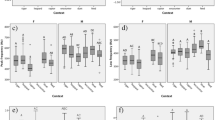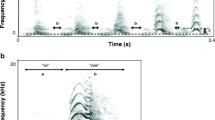Abstract
We report the results of an experiment designed to investigate whether captive cotton-top tamarins (Saguinus oedipus) selectively call back to an absent cagemate. We removed 2 individuals living in separate cages (cycling through the colony so that each individual was removed 10 times) from the homeroom and played back calls produced by one of them. The caller's cagemate, residing in the homeroom, was more likely to be the first individual to call back antiphonally than any other individual in the colony was. In support of previous work using both habituation-discrimination and phonotaxic techniques, our results show that cotton-top tamarins can recognize cagemates and possibly individuals by voice alone, and that the antiphonal playback method provides yet another tool for investigating acoustic perception in nonhuman primates.
Similar content being viewed by others
References
Cleveland, J., and Snowdon, C. T. (1982). The complex vocal repertoire of the adult cotton-top tamarin (Saguinus oedipus oedipus). Z. Tierpsychol. 58: 231-270.
Ghazanfar, A. A., Flombaum, J. I., and Hauser, M. D. (manuscript in preparation). Sex and volubility in cotton-top tamarins: An experimental study of long calling behavior.
Harcourt, A. H., Stewart, K., and Hauser, M. D. (1993). The social use of vocalizations by gorillas: I. Social behaviour and vocal repertoire. Behaviour 124: 89-122.
Jorgensen, D., and French, J. A. (1998). Individuality but not stability in marmoset long calls. Ethology 104: 729-742.
McGregor, P. K., and Dabelsteen, T. (1996). Communication networks. In Kroodsma, D. E., and Miller, E. H. (ed.), Ecology and Evolution of Acoustic Communication in Birds, Cornell University Press, Ithaca, NC0, pp. 409-425.
Miller, C. T., Miller, J., Gil da Costa, R., and Hauser, M. D. (2001). Selective phonotaxis by cotton-top tamarins. Behaviour 138: 811-826.
Mitani, J. C., and Stuht, J. (1998). The evolution of nonhuman primate loud calls: Acoustic adaptation for long-distance transmission. Primates 39: 171-182.
Norcross, J. L., and Newman, J. D. (1993). Context and gender-specific differences in the acoustic structure of common marmoset (Callithrix jacchus) phee calls. Am. J. Primatol. 30, 37-54.
Owings, D. H., and Morton, E. S. (1998). Animal Vocal Communication: A New Approach, Cambridge University Press, Cambridge, UC0.
Rendall, D., Seyfarth, R. M., Cheney, D. L., and Owren, M. J. (1999). The meaning and function of grunt variants in baboons. Anim. Behav. 57: 583-592.
Snowdon, C. T., and Cleveland, J. (1980). Individual recognition of contact calls by pygmy marmosets. Anim. Behav. 28: 717-727.
Snowdon, C. T., Cleveland, J., and French, J. A. (1983). Responses to context-and individual-specific cues in cotton-top tamarin long calls. Anim. Behav. 31: 92-101.
Waser, P. M. (1982). The evolution of male loud calls among mangabeys and baboons. In Snowdon, C. T., Brown, C. H., and Petersen, M. R. (eds.), Primate Communication, Cambridge University Press, New York, pp. 117-143.
Weiss, D. J., Garibaldi, B. T., and Hauser, M. D. (2001). The production and perception of long calls in cotton-top tamarins (Saguinus oedipus): Acoustic analyses and playback experiments. J. Comp. Psychol. 115: 258-271.
Weiss, D. J., and Hauser, M. D. (2002). Perception of harmonics in the combination long call of cotton-top tamarins (Saguinus oedipus). Anim. Behav. 64(3): 415-426.
West, M., and King, A. (1996). Eco-gen-atics: A systems approach to the ontogeny of avian communication. In Kroodsma, D. E., and Miller, E. H. (eds), Ecology and Evolution of Acoustic Communication in Birds, Cornell University Press, Ithaca, NC0, pp. 20-38.
Author information
Authors and Affiliations
Rights and permissions
About this article
Cite this article
Jordan, K., Weiss, D., Hauser, M. et al. Antiphonal Responses to Loud Contact Calls Produced by Saguinus oedipus . International Journal of Primatology 25, 465–475 (2004). https://doi.org/10.1023/B:IJOP.0000019162.31244.88
Issue Date:
DOI: https://doi.org/10.1023/B:IJOP.0000019162.31244.88




